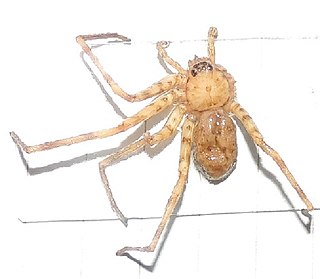
Corinnidae is a family of araneomorph spiders, sometimes called corinnid sac spiders. The family, like other "clubionoid" families, has a confusing taxonomic history. Once it was a part of the large catch-all taxon Clubionidae, now very much smaller. The original members of the family are apparently similar only in that they have eight eyes arranged in two rows, conical anterior spinnerets that touch and are generally wandering predators that build silken retreats, or sacs, usually on plant terminals, between leaves, under bark or under rocks.

The banded bullfrog is a type of frog in the microhylid family. It is also known as the Asian painted frog, Malaysian painted frog, Burmese painted frog, rice frog, and bubble frog. In the pet trade, it is sometimes called the chubby frog. They have round bodies with mahogany brown backs and cream stomachs. The distinctive stripes down the side can range from copper-brown to salmon pink in color. Males have darker throats than females. Frogs grow to about 8 cm (3 in) with females generally being larger than males. They may live for as long as 10 years. Although prevalent in the pet trade, very little is known regarding its behaviour in the wild. They exude a sticky mucus when threatened, which is not toxic but has an unpleasant taste. A former subspecies in South India and Sri Lanka is now known to be a separate, related species, Uperodon taprobanicus.

Carrhotus is a genus of jumping spiders that was first described by Tamerlan Thorell in 1891. The name is derived from the Greek Κάῤῥωτος.

Episinus is a genus of comb-footed spiders that was first described by Pierre André Latreille in 1809.
Psellocoptus is a genus of South American running spiders first described by Eugène Simon in 1896. When Eugène Simon discovered the first species, he described it as a "beautiful and large species from the forests of Venezuela which [is] found running rapidly on the trunks of trees". The species name flavostriatus means "striped yellow". P. buchlii is named after the late Harro Buchli, and the species name prodontus is from the Greek meaning "tooth in front".

Uperodon taprobanicus, also known as the Sri Lankan bullfrog, Sri Lankan painted frog, Sri Lankan kaloula, Ceylon kaloula, Indian painted frog, or painted globular frog, is a species of narrow-mouthed frog found in Nepal, Bangladesh, southern and eastern India, and Sri Lanka up to an altitude of about 1300 metres. It can grow to an adult length of up to 75 millimetres(7.5 cm) long from snout to vent. It was originally described as a subspecies of Kaloula pulchra, ssp. taprobanica. The IUCN lists it as being of "Least Concern".

Spiders are air-breathing arthropods that have eight legs, chelicerae with fangs generally able to inject venom, and spinnerets that extrude silk. They are the largest order of arachnids and rank seventh in total species diversity among all orders of organisms. Spiders are found worldwide on every continent except for Antarctica, and have become established in nearly every habitat with the exceptions of air and sea colonization. As of July 2019, at least 48,200 spider species, and 120 families have been recorded by taxonomists. However, there has been dissension within the scientific community as to how all these families should be classified, as evidenced by the over 20 different classifications that have been proposed since 1900.
Heligmomerus is a genus of armored trapdoor spiders that was first described by Eugène Louis Simon in 1892.
Copelatus taprobanicus is a species of diving beetle. It is part of the genus Copelatus in the subfamily Copelatinae of the family Dytiscidae. It was described by Wewalka & Vazirani in 1985.
Elaeocarpus taprobanicus is a species of flowering plant in the Elaeocarpaceae family used as a medicinal plant. It is one of three recently described species that is endemic to Sri Lanka.
Sphecotypus is a genus of corinnid sac spiders first described by O. Pickard-Cambridge in 1895.
Heligmomerus taprobanicus, is a species of spider of the genus Heligmomerus. It is endemic to Sri Lanka.

Olios lamarcki, is a species of spider of the genus Olios. It is found in Madagascar to Sri Lanka and India. The subspecies O. lamarcki taprobanicus is endemic to Sri Lanka.
Spariolenus taprobanicus, is a species of spider of the genus Spariolenus. It is endemic to Sri Lanka.

Spariolenus is a genus of Asian huntsman spiders that was first described by Eugène Louis Simon in 1880.
Carrhotus taprobanicus, is a species of spider of the genus Carrhotus. It is endemic to Sri Lanka.
Padillothorax taprobanicus is a species of spider of the genus Padillothorax. It is endemic to Sri Lanka.
Padillothorax is a genus of southeastern Asian jumping spiders first described by Eugène Simon in 1901. As of April 2019 it contains only two species.







